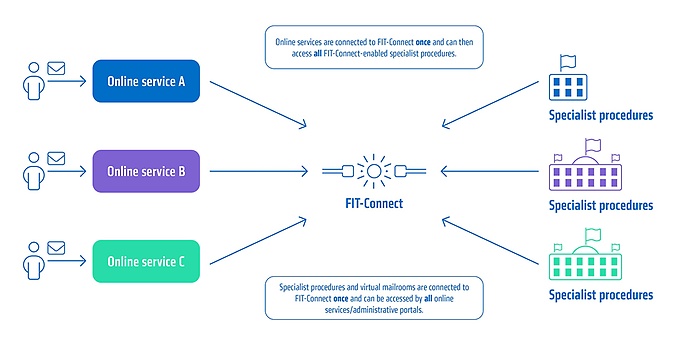4. July 2025 By Anna Jaspert
FIT-Connect: The digital postman for Germany's public administration
What is FIT-Connect?
Applying for parental allowance, registering a business or obtaining a fishing licence – all of this can now be done digitally in many places. But what actually happens after an application has been completed online? How does it end up at the right authority?
This is where FIT-Connect comes in: a central digital infrastructure that connects administrative portals and specialist procedures. FIT-Connect was developed by the Federal IT Cooperation (FITKO) – an organisation of the federal and state governments that ensures that digital solutions not only work within a federal state, but also interact nationwide. It is also a product of the IT Planning Council, which is financed by the federal and state governments. The registration of administrative systems and online services as well as the use of FIT-Connect as a technical infrastructure component are therefore free of charge.
Simply put, FIT-Connect is the central digital postman for applications and application-related communication between administrative portals and specialist procedures. Instead of linking each digital administrative service individually to the relevant specialist procedure, FIT-Connect ensures a uniform, central connection – in both directions. The Portalverbund-Online-Gateway (PVOG) automatically determines which specialist authority is responsible for the respective application. The data is transmitted there and encrypted end-to-end.

What role does FIT-Connect play in the digitisation of administrative services within the framework of the OZG?
The implementation of the Online Access Act (OZG) poses a major challenge for the federal government, the states and local authorities: administrative services must be digitally accessible nationwide – and they must be uniform, efficient and user-friendly. For this to succeed, different technical systems must be able to communicate with each other – despite federal structures and IT landscapes that have evolved over time. This is exactly where technical solutions such as FIT-Connect come in as a connecting infrastructure.
System diversity and lack of interoperability
IT is highly fragmented in Germany's federal administrative landscape. Each federal state, and often even each local authority, uses its own specialist procedures and portal solutions – frequently developed individually and without standardised interfaces. This diversity of systems is understandable given the history of the respective organisations, but it poses a major problem for comprehensive digitisation. After all, if administrative portals, specialist procedures and other IT components cannot communicate with each other, processes remain fragmented.
A cross-system mediation infrastructure such as FIT-Connect provides a remedy by providing a standardised interface that takes into account data formats such as XÖV and FIM and mediates between different systems.
Reusability and scalability of OZG services
An essential component of OZG implementation is the ‘one-for-all’ principle (EfA): individual states or municipalities develop digital administrative services that can then be used nationwide. This is intended to prevent each administration from digitising the same services independently, which ties up resources and leads to inconsistent solutions.
To ensure that centrally developed online services can actually be used everywhere, a technical solution is needed that connects them to the existing IT systems, regardless of whether these are municipal specialist procedures or state-specific platforms. A standardised mediation infrastructure such as FIT-Connect ensures that such services can be integrated into different administrative environments without major adaptation. This saves time and resources and makes nationwide use much easier.
Better communication between citizens, public authorities and businesses
Last but not least, the digitisation of public services is also about improving interaction with users. Many people and businesses not only want to be able to submit applications online, but also want transparency about what happens to their requests. In traditional administrative processes, this was often not provided for or only possible via telephone enquiries.
Technical solutions such as FIT-Connect, which go beyond mere application submission, enable bidirectional communication: citizens and users in companies can view the processing status of their application online, receive enquiries or provide feedback. This creates trust in digital services and increases acceptance – on both sides.
You can find out why its implementation is crucial for modern, digital administration in Germany in our blog post on the topic ‘What exactly is the Online Access Act?’
How widespread and accepted is FIT-Connect at present?
Since its launch in 2022, the use of FIT-Connect has grown steadily. Currently, 219 public authorities and 156 companies/manufacturers are actively connected, with continuous growth.
Despite this positive trend, there are still some uncertainties, particularly regarding the future viability of FIT-Connect and its classification in the context of EfA requirements and data security.
However, according to FITKO, FIT-Connect is intended as a permanent solution with a clear focus on stability and further development. In addition, the solution is EfA-compliant – FIT-Connect is even mentioned in the applicable minimum requirements as one of two options for the encrypted transmission of application data. With regard to data security, FITKO particularly emphasises end-to-end encryption as a security-related USP of FIT-Connect. This ensures the secure transmission of administrative data. The solution thus stands out from simpler connection options without comparable security mechanisms.
According to FITKO, the infrastructure is intended to develop beyond the OZG in the long term into a platform-like solution for digital administrative processes. The aim is to systematically eliminate media breaks and enable new digital offerings. I am excited to see how the platform develops and what use cases are added.
How is FIT-Connect being implemented in practice?
A successful FIT-Connect project does not begin with technology, but with a technical concept. The following aspects, among others, must be considered:
- Which administrative services are to be digitised or connected?
- Which technical procedures or other receiving systems are affected?
- What data is transmitted and how is it processed?
- What legal and organisational aspects must be taken into account?
A digital application is an important first step – but the real added value for citizens and businesses comes when the upstream and downstream processes are also consistently taken into account: Identification: How is the applicant identified or verified (e.g. BundID or Elster/Mein Unternehmenskonto)?
- Payment: Can fees be paid digitally during the application process?
- Processing status: Is feedback on the processing status provided to the applicant?
- Communication: How is communication with citizens handled, for example if information is missing?
These functions only work together effectively if all the systems involved are properly integrated – from specialist procedures and service portals to third-party providers.
Once the technical concept is in place, the detailed technical design and implementation can begin: In the detailed technical design, the defined requirements are specified and translated into an implementable technical design. This involves thinking through and preparing the planned processes, interfaces and system dependencies in detail. Based on the defined requirements, the necessary interfaces are then connected during implementation and data routing is configured via FIT-Connect. It is crucial to involve all IT and specialist departments at an early stage to ensure smooth implementation and stable operation.
Digital identities – secure, user-centric, future-proof
Whether logging in, conducting business with public authorities online or concluding digital contracts, digital identities are the key to secure authentication in a connected world. Find out more about how adesso supports companies and public authorities in developing trustworthy and scalable identity solutions – from eIDAS-compliant to wallet-ready.
How does adesso support FIT-Connect projects in the OZG context?
As a digitalisation partner in the public sector, adesso supports public administrations throughout all project phases: from technical design and implementation to productive rollout.
Whether as a sub-project in the OZG context, during integration into existing IT landscapes or as a sparring partner for process optimisation, adesso brings structure and experience to FIT-Connect projects and ensures that they are implemented efficiently, sustainably and in line with federal requirements.
Our experts support public institutions in the sustainable modernisation of their IT landscape and, with their in-depth methodological expertise, ensure that digitisation projects are implemented efficiently, securely and in a targeted manner – from classic consulting to agile project management. You can find an overview of our services for public administration on our website.
We support you!
Would you like to successfully introduce FIT-Connect in your administration? We support you from the initial idea to productive implementation – with expertise, experience and a clear understanding of federal structures.
Contact our experts now – and advance your digitalisation with FIT-Connect

